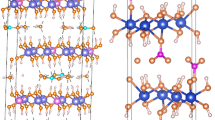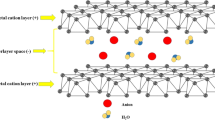Abstract
Inorganic layered nanoparticles, also known as anionic nanoclays, have great potential as delivery carriers, since they could efficiently intercalate anionic molecules into the gallery spaces and release the intercalated molecules in a controlled manner. They also exhibit low toxicity compared to other widely studied inorganic nanoparticles for biological purposes. In this review, we summarize and describe physicochemical factors influencing the cytotoxicity of layered nanoparticles in cultured cell lines for providing information on their optimum characteristics with minimized adverse effects.
Similar content being viewed by others
References
Vaccari, A. Preparation and catalytic properties of cationic and anionic clays.Catal. Today 41, 53–71 (1998).
Baes, C. F. & Mesmer, R. E. inThe Hydrolysis of Cations (A Willey-Interscience Publication, New York, 1976).
Cavani, F., Trifirò, F. & Vaccari, A. Hydrotalcite-type anionic clays: Preparation, properties and applications.Catal. Today 11, 173–301 (1991).
Choi, S. J., Oh, J. M. & Choi, J. H. Human-related application and nanotoxicology of inorganic particles: complementary aspects.J. Mater. Chem. 18, 615–620 (2008).
Conner, S. D. & Schmid, S. L. Regulated portals of entry into the cell.Nature 422, 37–44 (2003).
Oh, J. M., Choi, S. J., Kim, S. T. & Choy, J. H. Cellular uptake mechanism of an inorganic nanovehicle and its drug conjugates: enhanced efficacy due to clathrin-mediated endocytosis.Bioconjug. Chem. 17, 1411–1417 (2006).
Choi, S. J., Oh, J. M. & Choy, J. H. Anticancer druglayered hydroxide nanohybrids as potent cancer chemotherapy agents.J. Phys. Chem. Solids 69, 1528–1532 (2008).
Choi, S. J., Oh, J. M., Park, T. & Choy, J. H. Cellular toxicity of inorganic hydroxide nanoparticles.J. Nanosci. Nanotechnol. 7, 4017–4020 (2007).
Choi, S. J., Oh, J. M. & Choy, J. H. Safety aspect of inorganic layered nanoparticles; size-dependency in vitro and in vivo.J. Nanosci. Nanotechnol. 8, 5297–5301 (2008).
Choi, S. J., Oh, J. M. & Choy, J. H. Toxicology effects of inorganic nanoparticles on human lung cancer A549 cells.J. Inorg. Biochem. 103, 463–471 (2009).
Schins, P. F.et al. Inflammatory effects of coarse and fine particulate matter in relation to chemical and biological constituents.Toxicol. Appl. Pharm. 195, 1–11 (2004).
Oh, J. M.et al. Inorganic metal hydroxide nanoparticles for targeted cellular uptake through clathrin-mediated endocytosis.Chem- Asian J. 4, 67–73 (2009).
Arco, M. D.et al. Mg, Al layered double hydroxides with intercalated indomethacin: synthesis, characterization, and pharmacological study.J. Pharm. Sci. 93, 1649–1658 (2004).
Lanone, S.et al. Comparative toxicity of 24 manufactured nanoparticles in human alveolar epithelial and macrophage cell lines.Particle and Fibre Toxicol. 6, 14 (2009)
Oberdorster, G., Oberdorster, E. & Oberdorster, J. Nanotoxicology: an emerging discipline evolving from studies of ultrafine particles.Environ, Health Perspect. 113, 823–839 (2005).
Nel, A., Xia, T., Madler, A. & Li, N. Toxic potential of materials at the nanolevel.Science 311, 622–627 (2006).
Kipen, H. M. & Laskin, D. L. Smaller is not always better: nanotechnology yields nanotoxicology.Am. J. Physiol. Lung Cell. Mol. Physiol. 289, 696–697 (2005).
So, S. J., Jang, I. S. & Han, C. S. Effect of micro/nano silica particle feeding for mice.J. Nanosci. Nanotechnol. 10, 5367–5371 (2008).
Wang, B. et al. Acute toxicology impact of nano- and submicro-scaled zinc oxide powder on healthy adult mice.J. Nanosci. Nanotechnol. 10, 263–276 (2008).
Meng, H. et al. Ultrahigh reactivity provokes nanotoxicity: Explanation of oral toxicity of nano-copper particles.Toxicol. Lett. 175, 102–110 (2007).
Karlsson, H. L., Gustafsson, J., Cronholm, P. & Moller, L. Size-dependent toxicity of metal oxide particles-a comparison between nano- and micrometer size.Toxicol. Lett. 188, 112–118 (2009).
Baek, M. et al. Effects of different forms of anionic nanoclays on cytotoxicity.J. Nanosci. Nanotechnol. (In print).
Auffan, M., Rose, J., Wiesner, M. R. & Bottero, J. Y. Chemical stability of metallic nanoparticles: a parameter controlling their potential cellular toxicity in vitro.Environ. Pollut. 157, 1127–1133 (2009).
Author information
Authors and Affiliations
Rights and permissions
About this article
Cite this article
Yu, J., Baek, M., Chung, HE. et al. Physicochemical properties affecting the potentialin vitro cytotoxicity of inorganic layered nanoparticles. Toxicol. Environ. Health. Sci. 2, 149–152 (2010). https://doi.org/10.1007/BF03216498
Accepted:
Issue Date:
DOI: https://doi.org/10.1007/BF03216498




